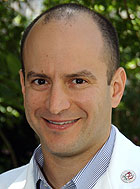Two recently discovered control networks that govern voluntary brain activity in adults start life as a single network in children, School of Medicine neuroscientists report.
Researchers previously showed the networks supervise most goal-oriented brain activity, enlisting the specialized talents of multiple brain regions for tasks such as reading a word or listening to music. They were surprised to find the two networks merged together in children.

“This has important implications not only for our thinking about how the architecture of the brain develops, but also for how that same structure breaks down in aging, disease and injury,” said senior author Bradley L. Schlaggar, M.D., Ph.D., assistant professor of pediatrics and of radiology.
The results appeared in the Proceedings of the National Academy of Sciences.
Neuroscientists have spent the past few decades pinning brain functions to small brain areas or collaborations between a few of those areas. But scientists have sometimes found it difficult to use this approach to predict how injuries to a given area of the brain will affect a patient’s cognitive abilities.
“We’re optimistic that answers to these problems and other important questions may lie in a more network-oriented approach that analyzes how several different brain regions regularly work with each other, exchanging data, directives and feedback,” said co-author Steven Petersen, Ph.D., the James McDonnell Professor of Cognitive Neuroscience and professor of neurology and of psychology.
In June, Petersen and his colleagues revealed that they had identified two control networks that seem to be in charge of much higher brain function. The two networks do not consult with each other but still work toward a common purpose: control of voluntary, goal-oriented behavior.
Scientists used a new brain scanning technique called resting state functional connectivity MRI to identify the control networks. Instead of analyzing mental activity when a volunteer works on a cognitive task, the new technique scans their brains while they do nothing. The scans reveal changes in the levels of oxygen in blood flowing to different areas of the brain. Researchers interpret correlations in the rise and fall of blood oxygen to different brain areas during inactivity as a sign that those areas likely work together.
For the new study, scientists analyzed the brains of 210 children, adolescents and adults. They found the two control networks are merged in children but begin pulling apart in adolescents. The prominent changes add another layer of intricacy to the challenge of predicting how brain injuries will affect patients.
“These networking changes mean a lesion in the same place in the brain could have different consequences depending on when it occurs,” said Schlaggar, also assistant professor of neurology and of neurobiology and anatomy.
Researchers also found a key component of the sustaining network in adults was closely linked in children to regions that eventually make up the heart of the adaptive network.
“We expected to find some differences in terms of these networks not being fully mature, but a complete switch of allegiance was not something our field would have predicted and is quite provocative,” Petersen said.